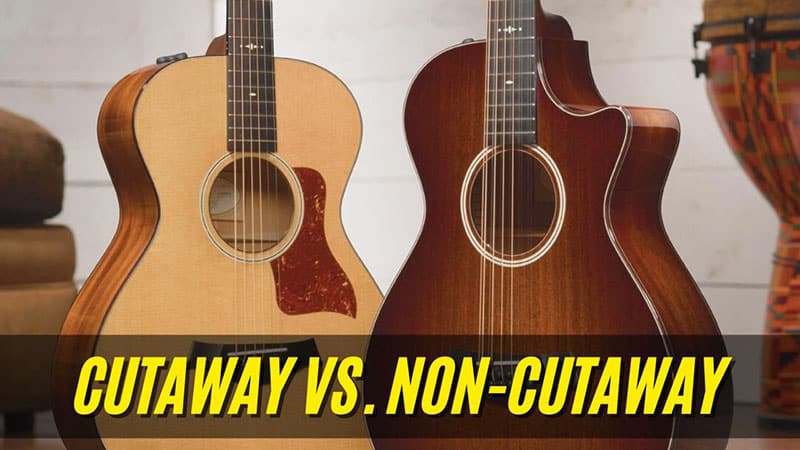There’s a lot of debate on cutaway vs. non-cutaway guitars and which one’s better for guitarists. If you’re unaware of the differences, then we have the answers for you right here!
A cutaway and non-cutaway guitar have a few differences between them. The main factors that separate these two types of guitar are the tonal difference and their body shapes. Also, cutaways allow you to get a bit more range than the non-cutaway guitars might provide.
But there’s a lot more to know about the differences between these guitars and what makes them distinct from each other. So, let’s dive in.
Differences Between Cutaway And Non-Cutaway
A cutaway is an arched dent on the neck area on the body of the guitar. It provides access to the higher fretboards, which allows you to reach a few more notes.
The cutaway and non-cutaway designs have both visual and tonal differences. It affects the shape of the guitar as well as its natural tone. It also offers a bit more range to a guitarist who wants to play in the high registers.
Here are a few factors that set these two types of guitar apart from one another.
Shape
A cutaway guitar’s shape is different from that of a non-cutaway style guitar. The obvious recess on the neck of the guitar in the cutaway design changes the vintage shape of the guitar and gives it a more modern appearance.
It’s a pretty subjective matter as few people prefer the original aesthetics of the guitar, where few just want better range from them.
Difference of Sound
Cutaway designs affect the natural tone of a guitar. As a guitar is structured to have a full-body shape, any physical modification to the guitars also modifies their original tonality.
A non-cutaway guitar has a fuller sound. Because its shape is just as it should be, it offers a balanced sound. These generate more volume and sound a lot smoother.
But the cutaway-style guitars have been intentionally deformed for getting better fretboard access. For this, it hampers its natural tone and has a bit more treble in its sound.
Fretboard Access
The reason for having a cutaway design is to have access to the higher fretboards on the guitar.
In the standard design of a guitar, the neck ends where it connects with the body, although the fretboard continues. So, the extended area of the fretboard remains unused in the non-cutaway designs.
But in cutaway guitars, the modified neck allows the guitarist to access the extended part of the fretboard. This access lets the guitarist get more creative with the notes.
Reasons For Choosing A Cutaway
A cutaway-style guitar is for those who want to play solos on the acoustic guitar. For them, having access to a few more notes is a blessing. It allows them to be more creative in the high register. It also produces a sound that has more treble in it.
So, you should go for a cutaway design if you play solos occasionally and want a more trebly sound from your guitar.
Reasons For Choosing A Non-Cutaway
The non-cutaway guitars are the standard designs of the guitars. The guitars are initially made in these full structures and then modified according to one’s needs. If you want a fuller sound from your guitar, which is equally balanced, then you should go for the non-cutaways.
They have a fuller sound because the intact body shape offers a sound with a bit more bass. It helps the overall sound to be balanced. These also have a symmetrical look which can look visually pleasing.
Alternative Option: Electric Acoustic Guitars
The cutaway guitars have less bass in them and have a relatively trebly sound. So, you can try electric acoustic guitars, also known as semi-electric guitars, to solve that problem.
These guitars have equalizers set up in them that will help you boost the missing low frequencies. You can also tone down the treble if it’s troubling you.
Which One Should You Get?
A preference for the style of the guitar shape depends upon what purpose you’re going to use it.
For example, playing guitar can cheer you up. You can also use it for regular live shows, where it has to deliver its premium sound every single time it’s plugged in. Or it can be used in home studios and professional studios by sound engineers in songs that need the magic of an acoustic guitar.
So, the cutaway and non-cutaway guitars have different purposes according to the reasons they are being used.
Live Shows
Usually, in live shows, acoustic guitars are used only for playing rhythm. Unless it’s a full acoustic program, people hardly play solos on an acoustic guitar.
The non-cutaway is the best option for them, as the overall balanced tone with a boosted low-end sound makes it worthwhile to have on a live setup.
But if somebody wants to play solos with an acoustic guitar in live shows, they should go for the cutaway guitars. That’s because cutaways can give them more flexibility and range.
Studio Recording
Recording an acoustic guitar is another different topic on its own. Sound engineers can make every type of tweak needed in the mix to make a song sound better.
In a song, an acoustic guitar dominates the mid registers of the song. So, the cutaway guitars are more than enough to serve that need unless the sound engineer wants the sound that non-cutaways provide.
Casual
Casual guitarists play only for peace of mind. They’re hardly so conscious about the technical side of the shape of the guitar. They’re rarely bothered, as long it serves their basic needs. For those guys, non-cutaways are just enough to get them going.
But if you want that pure acoustic guitar tone whenever you stroke the strings of your guitar, you should go for the non-cutaway style guitar. The balanced tone of the non-cutaway guitars is a wholesome experience, and you can take our word for it.
Final Note
The debate of cutaway vs. non-cutaway is everlasting. At the end of the day, it is up to one’s preference on how he wants his guitar to sound.
These slight modifications do have an emphasis on the structure and tone of the guitar. But what matters is how you, as a guitarist, can take that guitar and play it up to your advantage.


